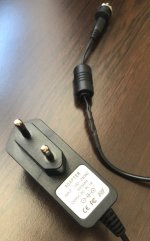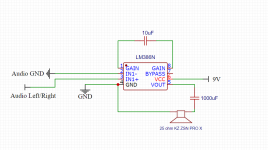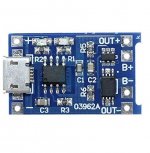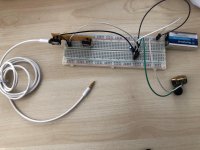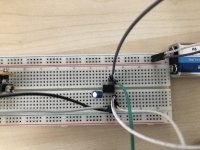Hi, i have got a problem with my lm386. I can't power it up with wall adapters.
When i'm trying to power an lm386 with a 9v battery, it works very well. How could i solve this problem ?
When i'm trying to power an lm386 with a 9v battery, it works very well. How could i solve this problem ?
Adapter
Here is a picture of one.
Here is a picture of one.
An externally hosted image should be here but it was not working when we last tested it.
pasteboard is not a good place to host images. Re-size appropriately and host here. See below.
What happens when you try? Smoke? Buzz? Do you have a voltmeter? Does the voltage read right both no-load and full-load? Is the polarity correct? What happened where the shrink-wrap is near the RFI-lump?
What happens when you try? Smoke? Buzz? Do you have a voltmeter? Does the voltage read right both no-load and full-load? Is the polarity correct? What happened where the shrink-wrap is near the RFI-lump?
Attachments
When i try to power the ic with this adapter, i get highly distorted audio signal . Adapter gives about 9.35 volts as i measured, also polarity is correct.
There are a couple possibilities:
1. Adapter has no filter cap? ( be sure your amp has a large cap across the power supply)
2. Grounding problems. Two-pin switch-mode adapters have a problem with grounding that places half the AC mains voltage on the output because there is no safety ground connection to connect the AC input filter to. Connecting your amp ground to earth ground will short this voltage the way a 3rd pin would. Linear transformer adapters generally don't have this problem because they have no switching noise filter on the mains input. For this reason, any switch-mode power supply requires an earth ground.
1. Adapter has no filter cap? ( be sure your amp has a large cap across the power supply)
2. Grounding problems. Two-pin switch-mode adapters have a problem with grounding that places half the AC mains voltage on the output because there is no safety ground connection to connect the AC input filter to. Connecting your amp ground to earth ground will short this voltage the way a 3rd pin would. Linear transformer adapters generally don't have this problem because they have no switching noise filter on the mains input. For this reason, any switch-mode power supply requires an earth ground.
Last edited:
Post a picture of your actual build.
Maybe/probably there is some grounding/decoupling problem which is easier seen than described.
The old "one image is worth 1000 words" 😉
Batteries are less critical in that aspect, they don´t hum, buzz, ripple, hiss, etc. but switching supplies often let some switching noise/hash through, let´s see what you have.
Well connected, it MUST work, and 1A is more than enough.
Maybe/probably there is some grounding/decoupling problem which is easier seen than described.
The old "one image is worth 1000 words" 😉
Batteries are less critical in that aspect, they don´t hum, buzz, ripple, hiss, etc. but switching supplies often let some switching noise/hash through, let´s see what you have.
Well connected, it MUST work, and 1A is more than enough.
Use a linear supply, with extra pF capacitors.
Or rechargeable cells (those from old cell phones last years).
You do have to charge them, put 2 * 3.7V in series, use a 9V adapter as charger.
Or rechargeable cells (those from old cell phones last years).
You do have to charge them, put 2 * 3.7V in series, use a 9V adapter as charger.
Post a picture of your actual build.
Maybe/probably there is some grounding/decoupling problem which is easier seen than described.
The old "one image is worth 1000 words" 😉
Batteries are less critical in that aspect, they don´t hum, buzz, ripple, hiss, etc. but switching supplies often let some switching noise/hash through, let´s see what you have.
Well connected, it MUST work, and 1A is more than enough.
Here is my circuit
Attachments
Use a linear supply, with extra pF capacitors.
Or rechargeable cells (those from old cell phones last years).
You do have to charge them, put 2 * 3.7V in series, use a 9V adapter as charger.
I'm also planning to use a 18650 li-ion battery hooked into a continously charged charging module if i will not be able to find a way to supply the circuit.
Attachments
Last edited:
Thanks, I asked for an actual picture of your build to troubleshoot it.Here is my circuit
Schematics do NOT show actual grounding, wire paths, layout, etc.
Thanks, I asked for an actual picture of your build to troubleshoot it.
Schematics do NOT show actual grounding, wire paths, layout, etc.
Are there any mistakes in my circuit ?
You do need a bypass on pin 7! Yes, sometimes it works without, but not as designed, and is super-susceptible to power rail feedback.
You really need a capacitor from +9V to GND, very close to the chip. A power rail bypass.
A battery on short leads is sufficient bypass for some '386. A long wire with an RFI filter from a wall supply is not good bypassing.
You really need a capacitor from +9V to GND, very close to the chip. A power rail bypass.
A battery on short leads is sufficient bypass for some '386. A long wire with an RFI filter from a wall supply is not good bypassing.
bypassing
Thanks for your reply, how can i bypass lm386 ? When i try to add an electrolytic capacitor between 9V and GND, it warms up after a while.
After taking a look at adapter, i saw that there is a cylindrical part connected to adapter's cable in series. It may cause distortion in circuit but i don't know.
Thanks for your reply, how can i bypass lm386 ? When i try to add an electrolytic capacitor between 9V and GND, it warms up after a while.
After taking a look at adapter, i saw that there is a cylindrical part connected to adapter's cable in series. It may cause distortion in circuit but i don't know.
What PRR said:
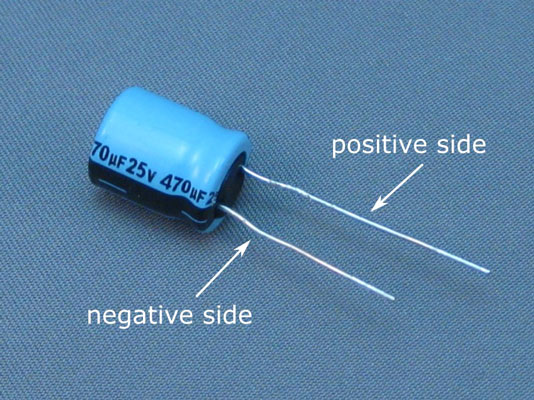
Same with the one feeding the speaker which by the way I can NOT find in your pictures 😱
Are you feeding DC into your speaker?
Try 100uF x 16V or 25VYou really need a capacitor from +9V to GND, very close to the chip. A power rail bypass.
Electrolytics have polarity, maybe you plugged it in upside down.When i try to add an electrolytic capacitor between 9V and GND, it warms up after a while.

Same with the one feeding the speaker which by the way I can NOT find in your pictures 😱
Are you feeding DC into your speaker?

sorry for late reply
I assembled the components to perfboard, i solved half of the problem with using a 7805 voltage regulator. But after a detailed research, i think i found the main problem. Ground looping. I tested the circuit in different rooms, different ac sockets. And i noticed that when i tested in living room there is no more noise except lm386's own noise(there weren't any devices plugged into sockets ). I'm gonna use this circuit when i'm using computer. So i don't want to listen noise instead of music. What should i do ?
I assembled the components to perfboard, i solved half of the problem with using a 7805 voltage regulator. But after a detailed research, i think i found the main problem. Ground looping. I tested the circuit in different rooms, different ac sockets. And i noticed that when i tested in living room there is no more noise except lm386's own noise(there weren't any devices plugged into sockets ). I'm gonna use this circuit when i'm using computer. So i don't want to listen noise instead of music. What should i do ?
- Home
- Amplifiers
- Power Supplies
- How to power lm386 up with wall adapters ?
